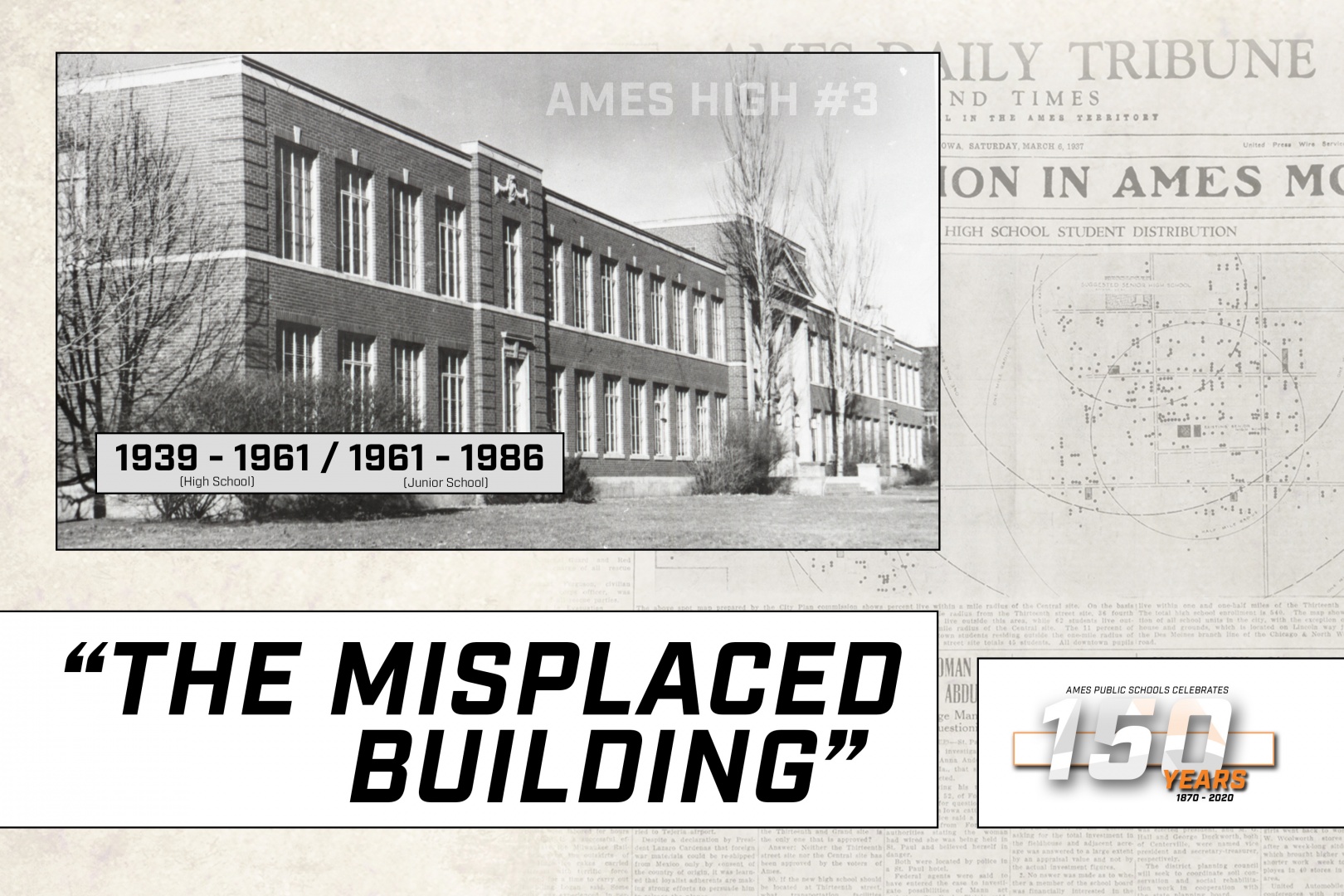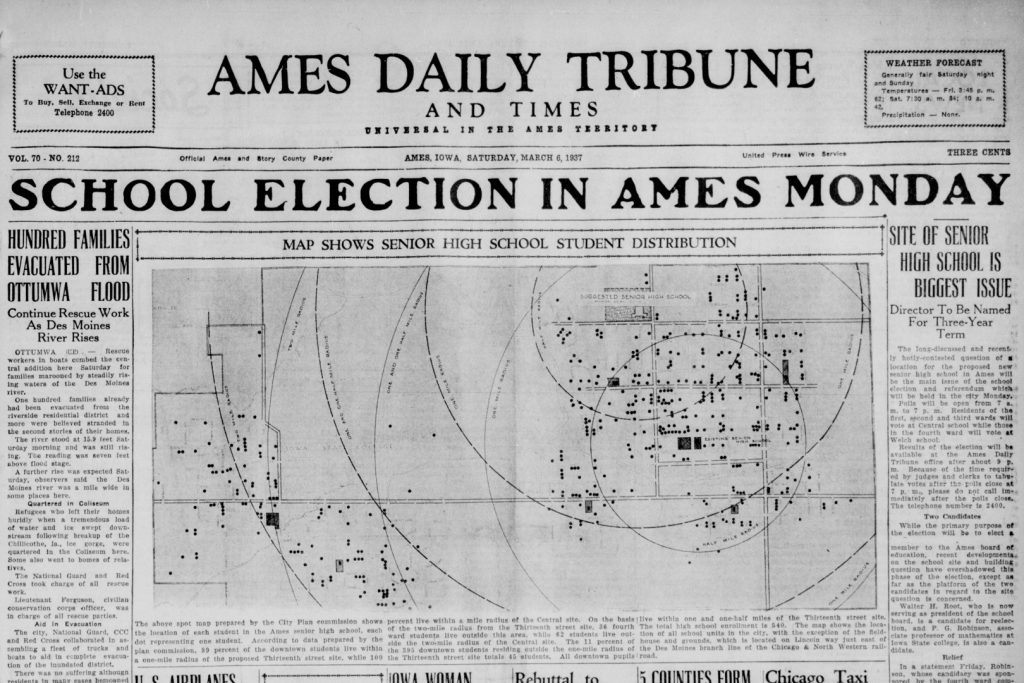The Misplaced Building: Story of Ames High #3

By 1936, the building known as “Old” Central (the 1911 building, aka Ames High #2), had become inadequate. Enrollment was on the rise in Ames and the building was exceeding its capacity. By December of that year, the school district started working with architects and the Ames Planning Commissions to look at designs of buildings and locations for the next Ames High School. The district had land available at the corner of 13th Street and Grand Avenue for the building. With a vote of 4-1, the School Board moved to build Ames High #3 on that property. This vote was unpopular to a group of community members and started one of the most interesting referendums in Ames Public School history.
The School Board based their vote on a number of recommendations from both the architects and Ames Planning Commission. The 20 acres of land allowed for a “campus” type of school with adequate parking, room for “physical training,” and most importantly, the opportunity for expansion. In 1936, there were not any houses north of 13th Street and objection to the vote quickly developed. A group known as the “4th Ward Committee,” who was comprised of citizens living in west Ames, claimed the location was too far away and they suggested several other sites. The group was led by E.C. McCracken, a professor at Iowa State College, who moved to Ames two years prior. He was the spokesperson for the group but had support from many other prominent community members including J.V. Atanasoff, who is best known for being credited with inventing the first electronic digital computer. They engaged in an active campaign to undo the school board’s vote. What transpired over the next several months was a community divided; the 4th Ward Committee versus the School Board.
The Board at the time was led by W.H. Root, but also included David Edwards and Warren Meeker, both of whom now have school buildings named in their honor. The 4th Ward Committee felt that the Grand Avenue and 13th Street location was like putting a school out in the country. They suggested several other locations including where the Fieldhouse was located and the land that is now Brookside Park. They argued that both of those locations would be most “central.”
With several locations being proposed, the School Board called on Paul C. Packer, Dean of the College of Education from the University of Iowa, to offer his expertise. Mr. Packer had considerable experience in building programs and selecting sites.
In a report to the school board, he indicated his top choice was the Grand Avenue and 13th Street location as it would provide “a satisfactory high school plant.” Packer admitted that the Field House location would be better than the Central school site, but also had some drawbacks. Finally, he strongly advised against building the new school on the central site. He noted that the central site did not allow for expansion, there was no off-street parking available, and furthermore, it would perpetuate the problem of students crossing the railroad tracks to utilize the Field House, which at the time housed the track, football field, and tennis courts. In 1937, the rail traffic was heavier than today as much of the switching of tracks took place in town. Ultimately, Packer believed that to build a high school on the central site would solve the problem of enrollment for only a short amount of time.
In February 1937, a public meeting was held by the 4th Ward Committee and they passed a resolution asking the school board to offer a referendum with three prospective sites. The School Board, in spite of having the authority to make the decision themselves, agreed to the proposal to let the citizens decide in a referendum that was scheduled for March 8, 1937. The Board chose two sites for the referendum: the central school site and the one at Grand Avenue and 13th Street. The date also served as the reelection of some school board members.
Leading into the referendum date, the Board asked for queries to be presented to the Board that would be answered publicly through the Ames Daily Tribune. A total of 118 questions were submitted, with approximately 58 of those coming from the 4th Ward Committee. The committee did not agree with many of the Board’s responses and provided a rebuttal to many of the items that was also printed in the Ames Daily Tribune. One such rebuttal asked, “Did Superintendent Davis do work under Dean Packer in his pursuance of an advanced academic degree?” The answer was “yes” but was meant to discredit the report that Packer submitted by calling attention to his relationship with the Superintendent. McCracken, as the voice of the 4th Ward Committee, said that “Dean Packer’s trip to Ames was merely a matter of form and only a verification of Superintendent Davis’ conclusions on the matter,” referring to Packer’s recommendation to build at 13th and Grand Avenue, in agreement with the school board.

The city was divided by the showdown of very prominent figures on both sides. Perhaps in a way to leverage support for the new location, the Ames Planning Commission printed a map of Ames High students within a two-mile radius of the two locations on the front page of the Ames Daily Tribune (March 6, 1937). The map showed that more students lived outside the two-mile radius for the central site compared to their proposed site at 13th and Grand.
On March 8, 1937, the Clark Street “central” location won by 299 votes and the School Board president, W.H. Root, was unseated by the Fourth Ward candidate who bested him by 17 votes. Thus, Ames High #3 became a landlocked building from its beginning and athletes still had to cross the railroad tracks and Lincoln Way to get access to the Field House and athletic fields.
The construction project introduced logistical challenges for teaching students. With “Old Central” (Ames High #1) torn down and the new one under construction, it was necessary to hold half-day sessions for high school and junior high students in the 1911 building. There were delays in the planning, design , and construction of the new Central building until the receipt of an unexpected $252,000 Federal PWA grant for construction of the auditorium and gymnasium. Until that time, the plans had only been made for classrooms. The law required that the money be used for immediate construction, so the large basement was dug and barricaded in the coldest period of the winter in order to comply with the requirements.
In addition to the large auditorium, gymnasium, and classrooms, the building contained laboratories for natural and physical sciences, an art room, a section to learn and practice stenography and office procedures, woodworking and metal shops, and an area for home economics work in food preparation and serving, sewing, and other phases of homemaking.
By 1958, the high school was quickly reaching its capacity of 800 students and the school board needed to consider building yet another high school. In November of that year, it was brought to a vote and the community was unified in its decision and overwhelmingly approved the bond issue for the new and the better-located school. The west Ames vote was 626 to 165 in support of the proposal.
Ames High #3 served as the high school for 22 years until a new high school (#4) was built at Ridgewood and 20th Street in 1961. When that happened, this building was used as a junior high until 1986. In 1990, it was remodeled and today serves as Ames City Hall.
Before Ames High #3 was built, the chairman of the 4th Ward Committee, E.C. McCracken, the person who was instrumental in keeping the high school central in Ames, accepted a position in Washington D.C. He moved before the new Ames High #3 school building opened.
Famed Ames Historian, Farwell T. Brown, said that the 1939 referendum was “a clash between academic disciplines.” The building was a fine structure but was a “misplaced building.” As a school, it was placed in the wrong environment to fulfill the educational needs of Ames students but “has now blossomed into a fuller life of public use and we now have a well-located City Hall.”